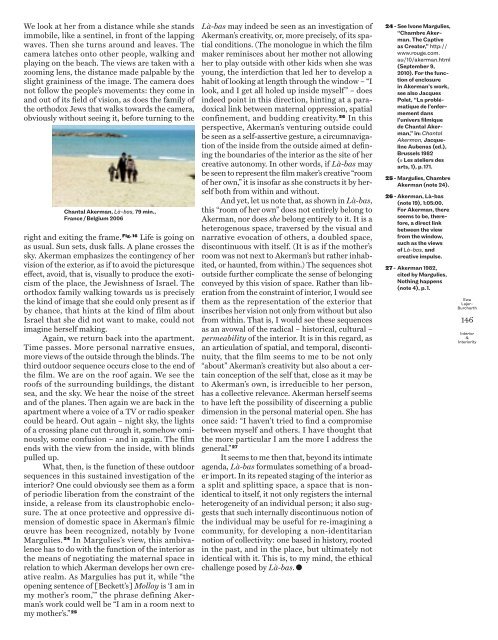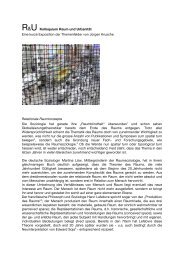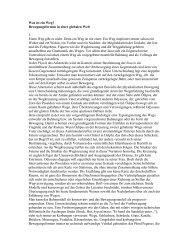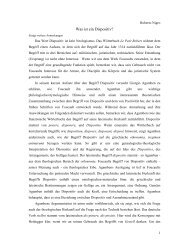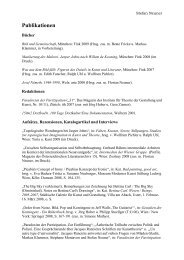Heft - Institut für Theorie ith
Heft - Institut für Theorie ith
Heft - Institut für Theorie ith
Erfolgreiche ePaper selbst erstellen
Machen Sie aus Ihren PDF Publikationen ein blätterbares Flipbook mit unserer einzigartigen Google optimierten e-Paper Software.
We look at her from a distance while she stands<br />
immobile, like a sentinel, in front of the lapping<br />
waves. Then she turns around and leaves. The<br />
camera latches onto other people, walking and<br />
playing on the beach. The views are taken w<strong>ith</strong> a<br />
zooming lens, the distance made palpable by the<br />
slight graininess of the image. The camera does<br />
not follow the people’s movements: they come in<br />
and out of its field of vision, as does the family of<br />
the orthodox Jews that walks towards the camera,<br />
obviously w<strong>ith</strong>out seeing it, before turning to the<br />
Chantal Akerman, Là-bas, 79 min.,<br />
France / Belgium 2006<br />
right and exiting the frame. Fig. 16 Life is going on<br />
as usual. Sun sets, dusk falls. A plane crosses the<br />
sky. Akerman emphasizes the contingency of her<br />
vision of the exterior, as if to avoid the picturesque<br />
e≠ect, avoid, that is, visually to produce the exoticism<br />
of the place, the Jewishness of Israel. The<br />
orthodox family walking towards us is precisely<br />
the kind of image that she could only present as if<br />
by chance, that hints at the kind of film about<br />
Israel that she did not want to make, could not<br />
imagine herself making.<br />
Again, we return back into the apartment.<br />
Time passes. More personal narrative ensues,<br />
more views of the outside through the blinds. The<br />
third outdoor sequence occurs close to the end of<br />
the film. We are on the roof again. We see the<br />
roofs of the surrounding buildings, the distant<br />
sea, and the sky. We hear the noise of the street<br />
and of the planes. Then again we are back in the<br />
apartment where a voice of a TV or radio speaker<br />
could be heard. Out again – night sky, the lights<br />
of a crossing plane cut through it, somehow ominously,<br />
some confusion – and in again. The film<br />
ends w<strong>ith</strong> the view from the inside, w<strong>ith</strong> blinds<br />
pulled up.<br />
What, then, is the function of these outdoor<br />
sequences in this sustained investigation of the<br />
interior? One could obviously see them as a form<br />
of periodic liberation from the constraint of the<br />
inside, a release from its claustrophobic enclosure.<br />
The at once protective and oppressive dimension<br />
of domestic space in Akerman’s filmic<br />
œuvre has been recognized, notably by Ivone<br />
Margulies. 24 In Margulies’s view, this ambivalence<br />
has to do w<strong>ith</strong> the function of the interior as<br />
the means of negotiating the maternal space in<br />
relation to which Akerman develops her own creative<br />
realm. As Margulies has put it, while “the<br />
opening sentence of [Beckett’s] Molloy is ‘I am in<br />
my mother’s room,’” the phrase defining Akerman’s<br />
work could well be “I am in a room next to<br />
my mother’s.” 25<br />
Là-bas may indeed be seen as an investigation of<br />
Akerman’s creativity, or, more precisely, of its spatial<br />
conditions. (The monologue in which the film<br />
maker reminisces about her mother not allowing<br />
her to play outside w<strong>ith</strong> other kids when she was<br />
young, the interdiction that led her to develop a<br />
habit of looking at length through the window – “I<br />
look, and I get all holed up inside myself ” – does<br />
indeed point in this direction, hinting at a paradoxical<br />
link between maternal oppression, spatial<br />
confinement, and budding creativity. 26 In this<br />
perspective, Akerman’s venturing outside could<br />
be seen as a self-assertive gesture, a circumnavigation<br />
of the inside from the outside aimed at defining<br />
the boundaries of the interior as the site of her<br />
creative autonomy. In other words, if Là-bas may<br />
be seen to represent the film maker’s creative “room<br />
of her own,” it is insofar as she constructs it by herself<br />
both from w<strong>ith</strong>in and w<strong>ith</strong>out.<br />
And yet, let us note that, as shown in Là-bas,<br />
this “room of her own” does not entirely belong to<br />
Akerman, nor does she belong entirely to it. It is a<br />
heterogenous space, traversed by the visual and<br />
narrative evocation of others, a doubled space,<br />
discontinuous w<strong>ith</strong> itself. (It is as if the mother’s<br />
room was not next to Akerman’s but rather inhabited,<br />
or haunted, from w<strong>ith</strong>in.) The sequences shot<br />
outside further complicate the sense of belonging<br />
conveyed by this vision of space. Rather than liberation<br />
from the constraint of interior, I would see<br />
them as the representation of the exterior that<br />
inscribes her vision not only from w<strong>ith</strong>out but also<br />
from w<strong>ith</strong>in. That is, I would see these sequences<br />
as an avowal of the radical – historical, cultural –<br />
permeability of the interior. It is in this regard, as<br />
an articulation of spatial, and temporal, discontinuity,<br />
that the film seems to me to be not only<br />
“about” Akerman’s creativity but also about a certain<br />
conception of the self that, close as it may be<br />
to Akerman’s own, is irreducible to her person,<br />
has a collective relevance. Akerman herself seems<br />
to have left the possibility of discerning a public<br />
dimension in the personal material open. She has<br />
once said: “I haven’t tried to find a compromise<br />
between myself and others. I have thought that<br />
the more particular I am the more I address the<br />
general.” 27<br />
It seems to me then that, beyond its intimate<br />
agenda, Là-bas formulates something of a broader<br />
import. In its repeated staging of the interior as<br />
a split and splitting space, a space that is nonidentical<br />
to itself, it not only registers the internal<br />
heterogeneity of an individual person; it also suggests<br />
that such internally discontinuous notion of<br />
the individual may be useful for re-imagining a<br />
community, for developing a non-identitarian<br />
notion of collectivity: one based in history, rooted<br />
in the past, and in the place, but ultimately not<br />
identical w<strong>ith</strong> it. This is, to my mind, the ethical<br />
challenge posed by Là-bas.<br />
24 - See Ivone Margulies,<br />
“Chambre Akerman.<br />
The Captive<br />
as Creator,” http://<br />
www.rouge.com.<br />
au/10/ akerman.html<br />
(September 9,<br />
2010). For the function<br />
of enclosure<br />
in Akerman’s work,<br />
see also Jacques<br />
Polet, “La problématique<br />
de l’enfermement<br />
dans<br />
l’univers filmique<br />
de Chantal Akerman,”<br />
in: Chantal<br />
Akerman, Jacque -<br />
line Aubenas (ed.),<br />
Brussels 1982<br />
(= Les ateliers des<br />
arts, 1), p. 171.<br />
25 - Margulies, Chambre<br />
Akerman (note 24).<br />
26 - Akerman, Là-bas<br />
(note 19), 1:05:00.<br />
For Akerman, there<br />
seems to be, therefore,<br />
a direct link<br />
between the view<br />
from the window,<br />
such as the views<br />
of Là-bas, and<br />
creative impulse.<br />
27 - Akerman 1982,<br />
cited by Margulies,<br />
Nothing happens<br />
(note 4), p. 1.<br />
Ewa<br />
Lajer-<br />
Burcharth<br />
146<br />
Interior<br />
&<br />
Interiority


